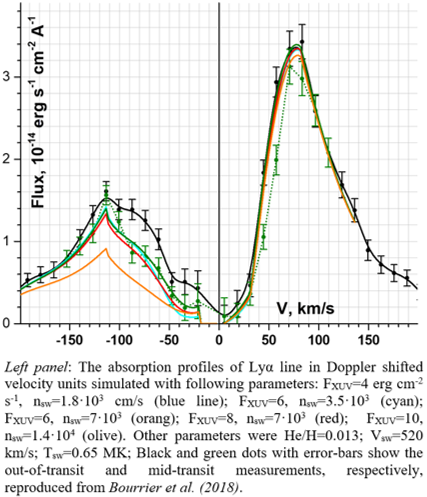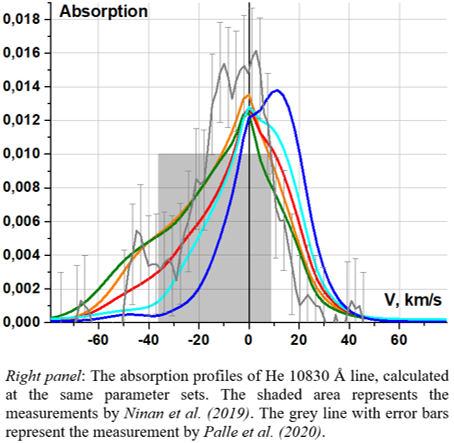Global 3D hydrodynamic modeling of GJ3470b and transit absorption in Lyα and He 10830 A lines
- Institute of Laser Physics SB RAS, Novosibirsk, Russian Federation (ildars@ngs.ru)
The aeronomy hydrodynamic simulation Salz et al. (2016) has shown that the warm Neptune GJ 3470b should have one of the largest mass loss rates due to its low mass, close orbit and relatively high activity of the host star. The Lyα observation of GJ 3470b reported in Bourrier et al. (2018) revealed large absorption depths of ~35 % in the blue wing [-94; -41] km/s of the line. Different to similar warm Neptune GJ 436b, significant absorption depth of ~23 % was detected also in the red wing [23; 76] km/s, as well as a relatively short transit duration of ~2 hours without any distinct early ingress and extended egress phases.
Thus, GJ 3470b appears to be the second hot exoplanet with a large hydrogen envelope extending far beyond the Roche lobe. Moreover, besides of the hydrogen related Lyα, also the absorption in line 10830 Å of metastable helium has been detected for this planet. Ninan et al. (2019) reported about 1% absorption averaged over the line width of 1.2 Å taking place mostly at the blue wing [-36; 9] km/s of the line. The simulation, based on 1D profiles of helium atoms and ions performed in Salz et al. (2016) assuming standard abundance He/H=0.1, yielded the column density of He(23S) atoms one order of magnitude larger than that inferred from the observations. Very recently new three transits at the 10830 Å line have been reported by Palle et al. (2020). The spectro-photometric light curve has been obtained, which shows that absorption by He(23S) atoms coincides with the expected ingress and egress times. The spectrally resolved absorption at transit shows the depth of 1.5% around the line center restricted by the interval [-30; 20] km/s, while the half width interval is [-22; 10] km/s.
In the present paper we use a 3D global hydrodynamic multifluid code which allows fully self-consistent calculation of the formation of the escaping planetary wind (PW) of hot exoplanets and its interaction with the stellar wind (SW). Previously we employed this code to interpret the Lyα absorption at GJ 436b Khodachenko et al. (2019) and the absorption in HI, OI, CII, SiIII resonant lines at hot Jupiter HD209458b Shaikhislamov et al. (2020). For the GJ 3470b, we calculate the absorption in both, Lyα and He 10830 Å lines. A number of simulation runs with different modelling parameter sets has been performed, assuming slow and fast SW conditions and using the estimated XUV and Lya fluxes of the star.
The obtained results show that, similar to findings in Khodachenko et al. (2019) regarding GJ436b, the Lyα transit for GJ3470b is produced by ENAs formed in course of the interaction between the escaping PW and surrounding SW. As in the case of our previous studies of HD20458b and GJ436b, the role of the radiation pressure has been found to be insignificant. The simulation runs with different modelling parameter sets revealed that the observed fast decay of the Lyα absorption in the egress part of the transit light-curve can be the result of sufficiently high ram pressure of fast SW, which rapidly blows away from the orbital line the trailing tail of escaping planetary atmospheric material. The applied model is able to reproduce, within the measurements error margins, the 10% Lyα absorption at the red-shifted velocities of about 80 km/s, as well as 20% absorption, averaged over the whole red wing of the line. The red-shifted Lyα absorption is produced in the shocked region by ENAs, which have sufficiently high velocity dispersion to provide absorption in the blue and red parts of the line. The best fit parameters of the SW correspond in the temperature and velocity to the fast Solar wind and imply for the parent star of GJ3470b the total mass loss rate of 0.1 of the Solar value, which is compatible with the smaller than the Sun size of the star.
Similarly to 1D modeling of Ninan et al. (2019) and Palle et al. (2020), we found that He(23S) atoms produced by GJ3470b outflow extend to the distances of at least 10 planet radii. To fit the He(23S) absorption at the same parameters, as those derived to fit the Lyα absorption, the helium abundance in the upper atmosphere of GJ3470b should be He/H≈0.015, i.e. about an order of magnitude lower than the Solar value. At the same time, a good agreement of the simulated absorption profile with the measurements was found.
The comparative study of various pumping and depopulation processes of He(23S) state has shown that the interpretation of the measured absorption in 10830 Å line can be quite intricate, because in different regions of the escaping planetary material, as well as in the shocked region, different processes are responsible for the production of absorbing agent. Altogether, the performed 3D self-consistent multi-fluid simulations of the expanding and escaping upper atmosphere of GJ3470b and the related spectral absorption features and transit light-curves have shown that the available observational data can be relatively well interpreted within the range of reasonable values of physically justifiable parameters related with the planetary atmospheric composition, stellar XUV flux and SW plasma flow.


Acknowledgements:
This work was supported by grant № 18-12-00080 of the Russian Science Foundation. Parallel computing simulations, key for this study, have been performed at Computation Center of Novosibirsk State University and SB RAS Siberian Supercomputer Center.
References
Bourrier V. et al. (2018). A&A, 620, A147
Khodachenko M. L. et al. (2019). ApJ, 885(1), 67
Ninan J. P. et al. (2019). preprint arXiv:1910.02070
Palle E. et al. (2020). A&A, 638, A61
Salz M. et al. (2016). A&A, 586, A75
Shaikhislamov I. F. et al (2020). MNRAS, 491(3), 3435
How to cite: Shaikhislamov, I. F. and Khodachenko, M. L.: Global 3D hydrodynamic modeling of GJ3470b and transit absorption in Lyα and He 10830 A lines, Europlanet Science Congress 2020, online, 21 Sep–9 Oct 2020, EPSC2020-147, https://doi.org/10.5194/epsc2020-147, 2020.

